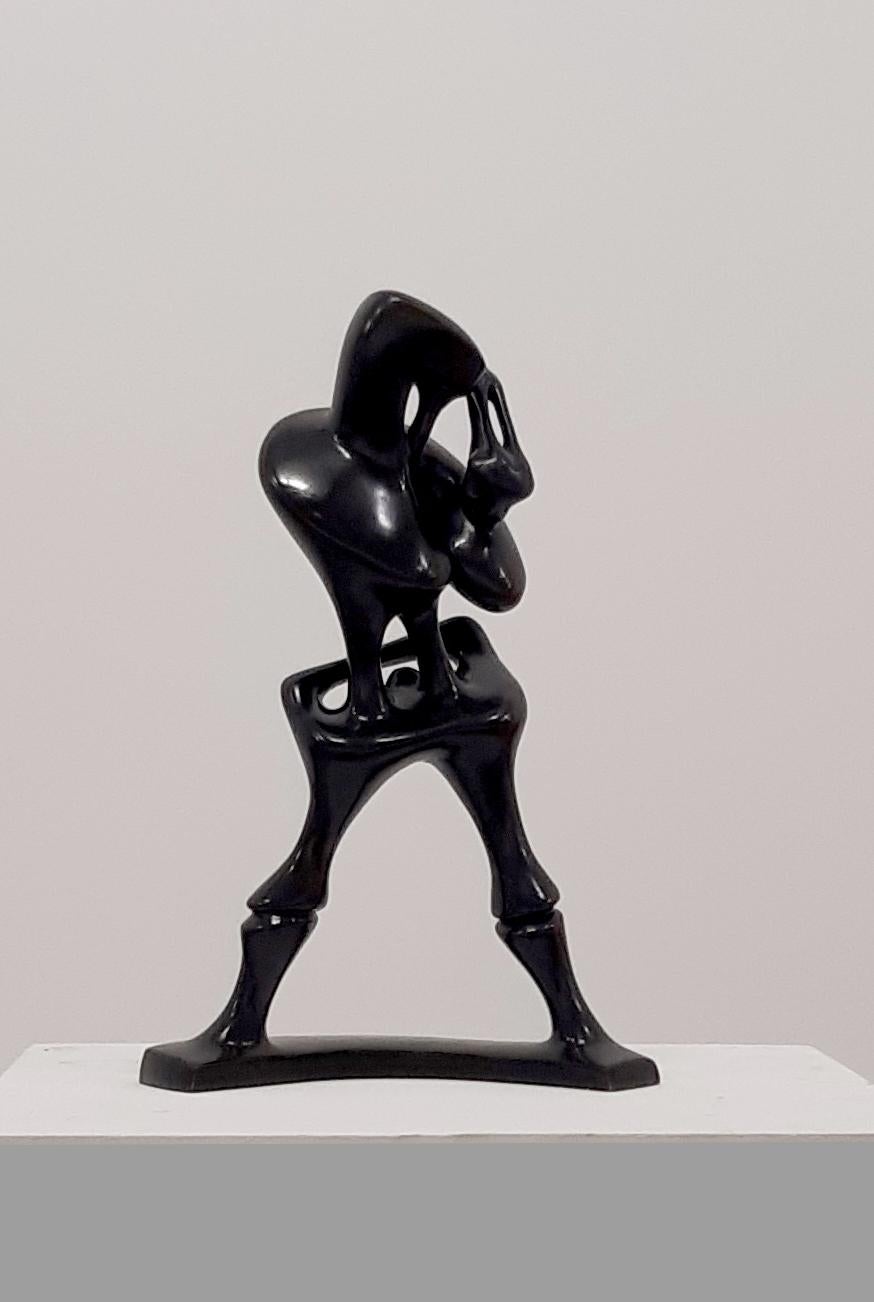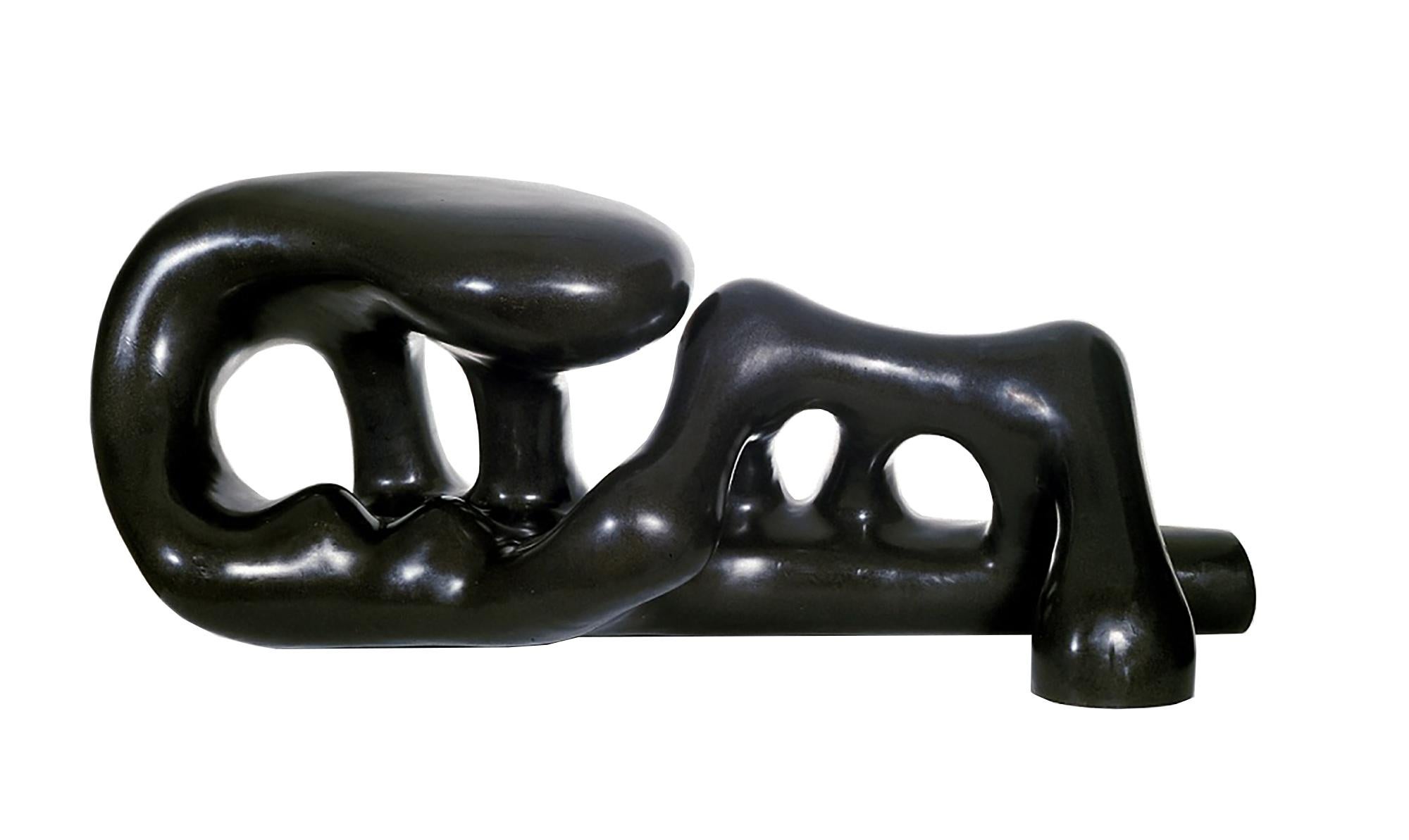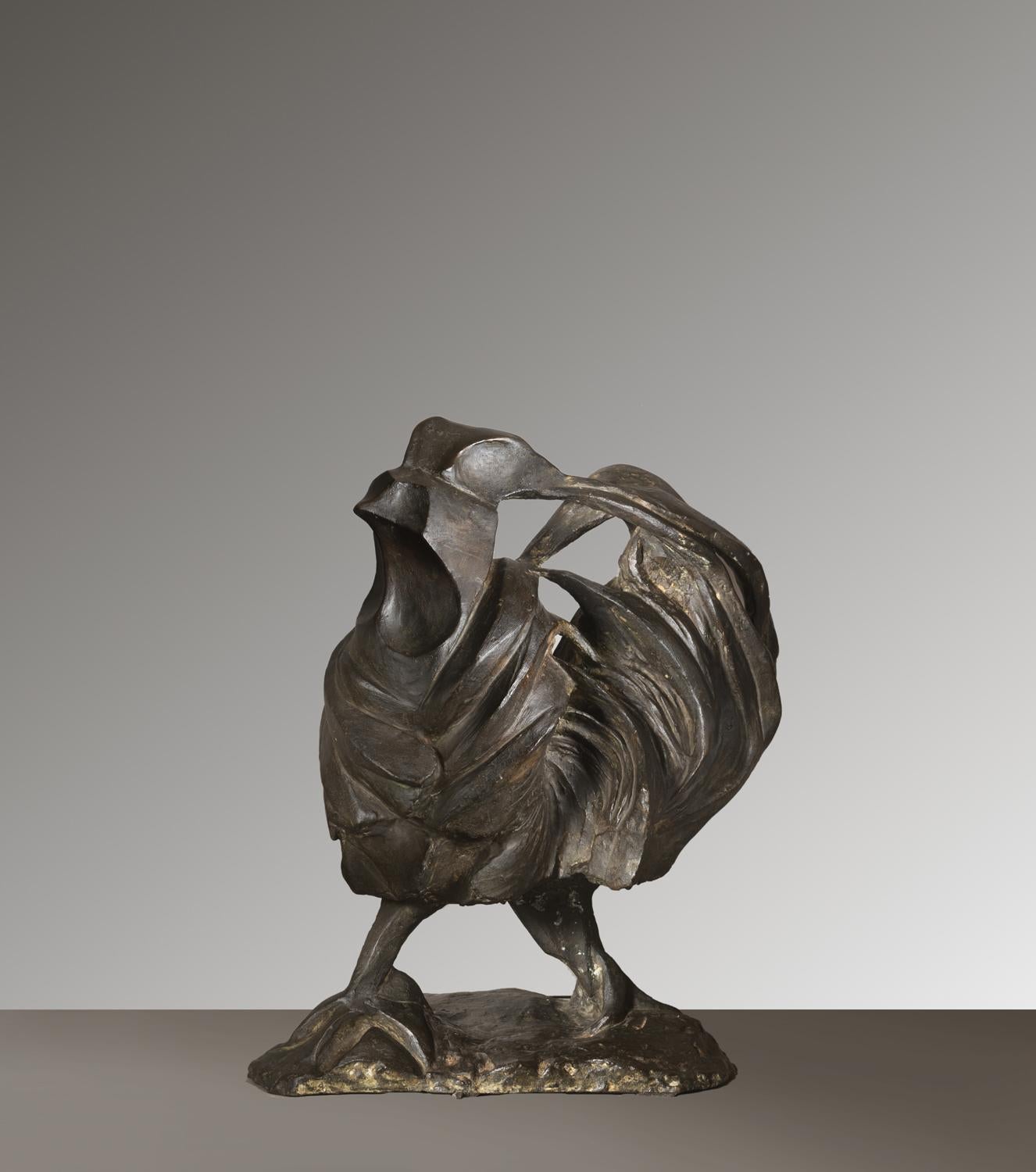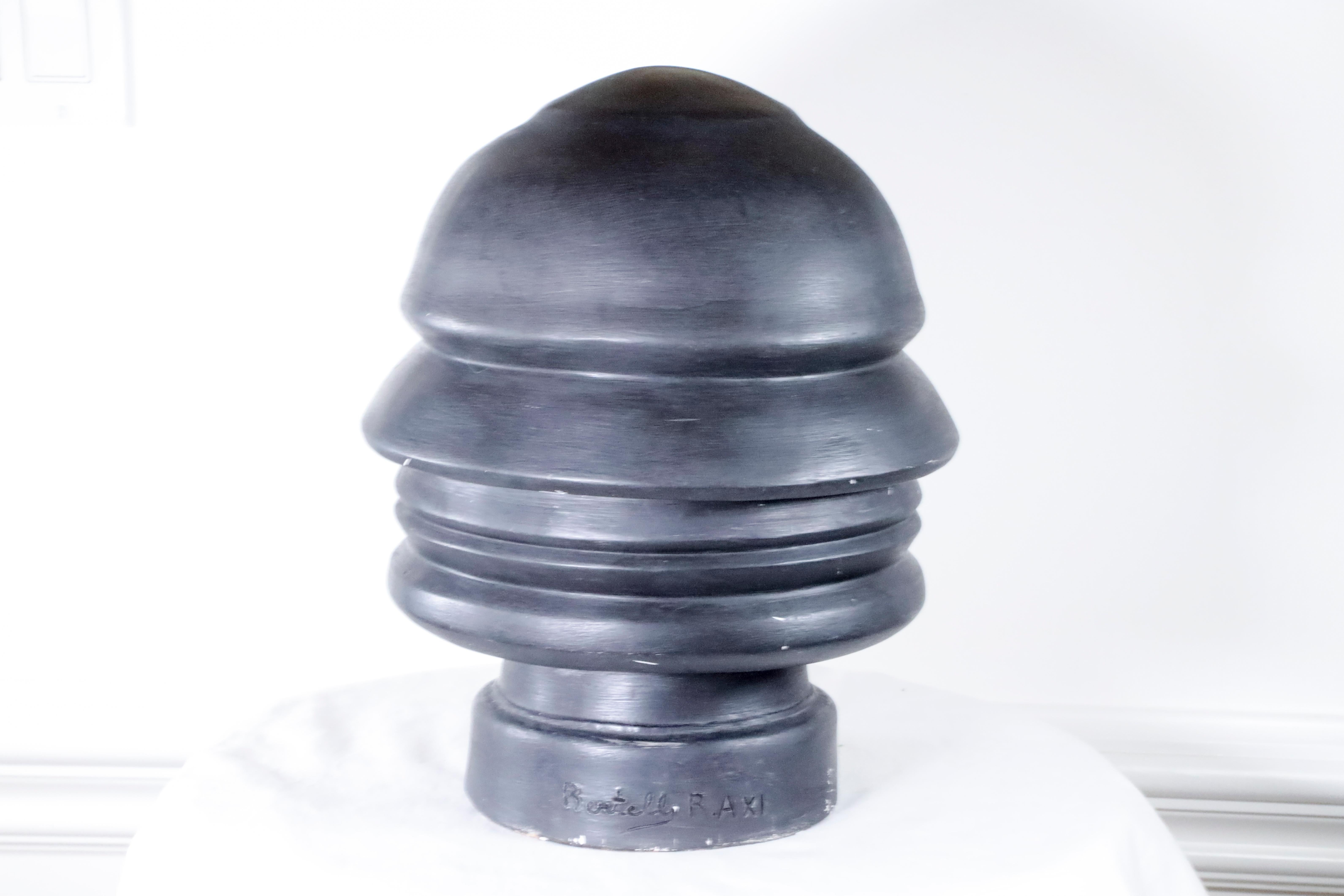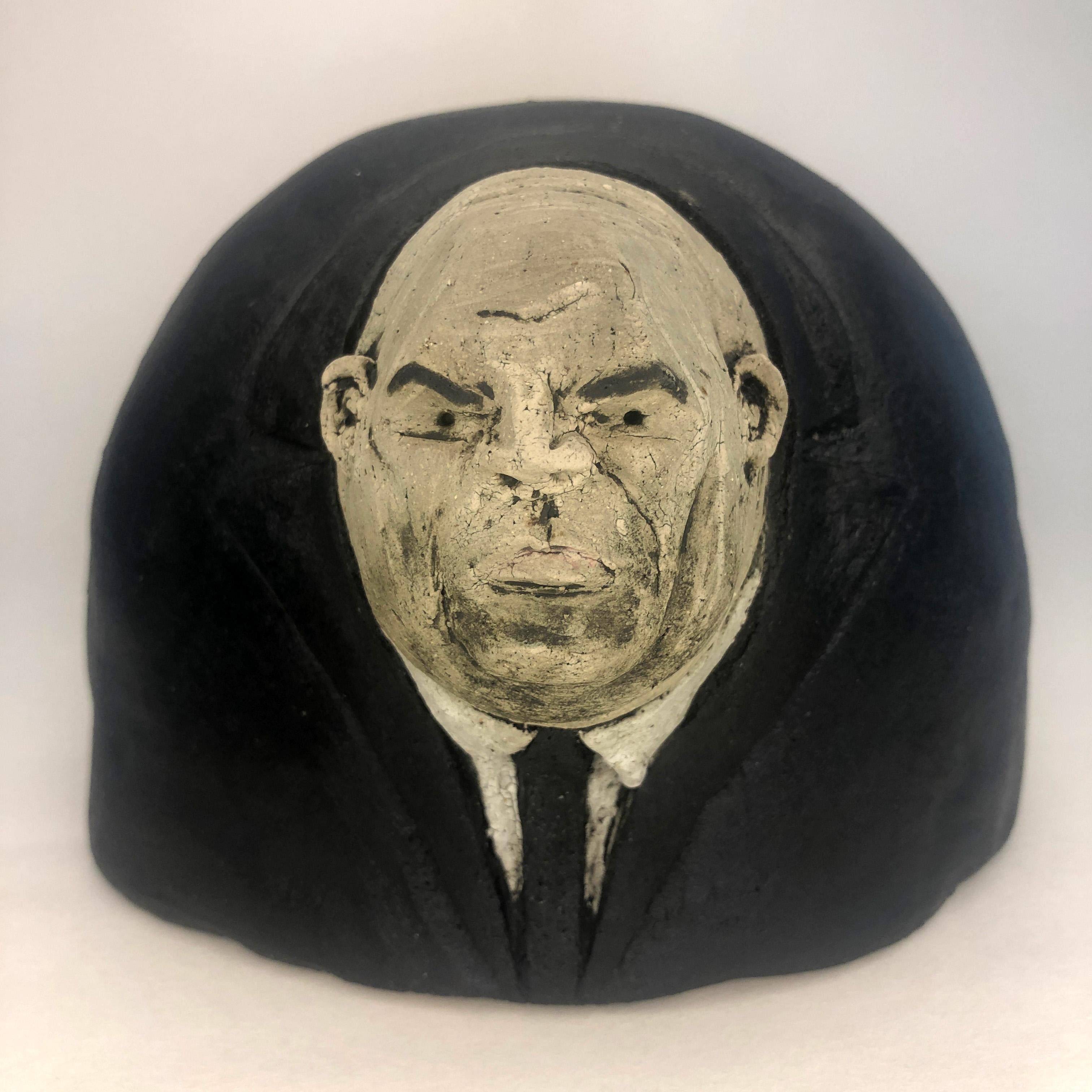Items Similar to Agustín Cárdenas, El Violinista, Bronze, Edition 3/3, 1989, Big size
Want more images or videos?
Request additional images or videos from the seller
1 of 4
Agustín CárdenasAgustín Cárdenas, El Violinista, Bronze, Edition 3/3, 1989, Big size1989
1989
About the Item
Agustín Cárdenas
El Violinista, 1989
Bronze. Ed. 3/3
177 x 120 x 61 cm 69.6 x 47.2 x 24 in.
AGUSTIN CARDENAS
(b. 1927, Matanzas, Cuba; d. 2001 Havana, Cuba)
Agustín Cárdenas entered the San Alejandro Academy of Fine Art in 1943 and studied there until 1949. He was a founder and prominent activist of the Los Once Group who introduced Abstraction as a renewing trend of the visual arts in Cuba between 1953 and 1955. He arrived in France in 1955 and settled in Montparnasse. He met André Breton, who invited him to participate in a group exhibition at the Surrealist Gallery, l’Étoile Scellée. He was made a Knight of the Order of Arts and Letters, a Knight of the Legion of Honour and received the William and Norma Copley Foundation Award. From 1968, Cárdenas lived and worked in Meudon, Bellevue, and at his studio in Nogent-sur-Marne. Augustin Cárdenas, embodies his Latin American and African origins, its strong symbolism and extreme liberty frees it from their respective references. Working with wood, marble, and bronze, Cárdenas developed poetic, curved, and sensual works in which organic generosity, elongated silhouettes, and abstract forms all mix together. The abstract nature of his volumes is almost always counterbalanced by a figurative representation.
His works are included in numerous museum collections including those of the Musée d’Art Moderne in Paris, the Museo d’Arte Moderna in Rome, the Museo de Arte Moderno in Caracas, the Pompidou Centre in Paris, the Museo Nacional in Cuba, the Modern Art Museum in Tel Aviv, and the Hakone open-air Museum in Japan.
- Creator:Agustín Cárdenas (1927 - 2006, Cuban)
- Creation Year:1989
- Dimensions:Height: 69.6 in (176.79 cm)Width: 47.2 in (119.89 cm)Depth: 24 in (60.96 cm)
- Medium:
- Movement & Style:
- Period:
- Condition:
- Gallery Location:Miami, FL
- Reference Number:1stDibs: LU161329040742
About the Seller
5.0
Vetted Seller
These experienced sellers undergo a comprehensive evaluation by our team of in-house experts.
Established in 1989
1stDibs seller since 2021
Typical response time: 1 to 2 days
- ShippingRetrieving quote...Ships From: Miami, FL
- Return PolicyA return for this item may be initiated within 14 days of delivery.
More From This SellerView All
- Agustín Cárdenas, El Violinista, Bronze, Edition 4/6, 1983, Small sizeBy Agustín CárdenasLocated in Miami, FLAgustín Cárdenas El Violinista, 1989 Bronze. Ed. 4/6 54 x 36 x 22 cm 21.2 x 14.1 x 8.6 in. AGUSTIN CARDENAS (b. 1927, Matanzas, Cuba; d. 2001 Havana,...Category
1980s Futurist Figurative Sculptures
MaterialsBronze
- Agustín Cárdenas, Le Repos Passionné, 1989, Bronze. Edition 7/7By Agustín CárdenasLocated in Miami, FLAgustín Cárdenas Le Repos Passionné, 1989 Bronze. Ed. 7/7 60 x 145 x 51.5 cm 23.6 x 57 x 20.2 in. The artwork is accompanied by a certificate of aut...Category
1980s Futurist Figurative Sculptures
MaterialsBronze
- Cornelis Zitman, Divertimiento, 1973, Bronze, 72 x 34 x 45 cmLocated in Miami, FLCornelis Zitman Divertimiento, 1973 Bronze, AP 72 x 34 x 45 cm 28.3 x 13.3 x 17.7 in. Cornelis Zitman (1926-2016) Born in Leiden in a family of builders, he enters the Fine Arts ...Category
1970s Figurative Sculptures
MaterialsBronze
- Maqueta las toninasLocated in Miami, FLMaqueta las Toninas, 1944 BMY-022, 1970 Edition 1/25 Bronze 22 x 22 x 10 cm 8.6 x 8.6 x 3.9 in ABOUT THE ARTIST Narvaez was born in Porlamar, Venezuela, in 1905; he was the fifth son of eleven siblings; his parents were Jose Lorenzo Narvaez and Vicenta Rivera. Don José Lorenzo, a multifaceted and creative man, sowed the seed of creativity in his son. “My father did not fit in with his fantasies of cabinetmaker, bricklayer, master builder, and self-taught architect.”1 From an early age, Francis was led to the artistic activity, he traced, carved, made replicas of the furniture and the saints restored by his father. In 1920 he obtained his first professional assignment, a San Rafael for the Church of Carupano, and, in 1922, his father authorized him to travel to Caracas to pursue his studies as an artist. He studied at the atelier of Marcos Castillo, at of the Angel Cabre y Magriña and at the Academy of Fine Arts in Caracas, where he was introduced to the painters and intellectuals of the time. In 1928 he presented his first solo exhibition at the Club Venezuela. With the money raised from the sale of the works and the support of Monsignor Sosa, and the Ministers Centeno Grau and Arcaya, he studied in Paris on a scholarship. Once there, he enrolled at the Académie Julian, where Tito Salas, Cristóbal Rojas and Arturo Michelena had also studied. It was in Paris where, unable to work in wood, he turned to stone carving. “In Paris, I didn’t have wood, so I carved a lot in stone (…), when there were demolitions I purchased chunks of stone, I would take them to the workshop and carve them.”2 His first attempts at volumetric sculptures and painting in plain colours, linked to the thematic of American miscegenation and Creole reality, can be traced back to that first trip to Paris. During his stay in the French city, Arturo Uslar Pietri, Alfredo Boulton, and Finita Vallenilla supported the artist both financially and logistically, and in February of 1930, the trio of friends arranged another exhibition for him at the Club Venezuela. Narvaez describes his exhibition as follows: “(…) in it I feel that the sculptural work is more my own, done with more assurance, a response to my pursuit of large planes, stylisation and synthesis.”3 By then, as Boulton himself noted in his book about the artist, Narvaez departed from most of the artistic traditions that prevailed by that time in Venezuela. In 1931 he returned to Caracas and established his atelier at the Barrio Obrero in Catia. The atelier became the hub of the intellectual life of the time. “In those years, the atelier of Francisco Narvaez was the hub of the greatest Venezuelan hope. Nothing comparable to it can be found either before or since.”4 From that year onwards, exhibitions, projects, trips, and awards we multiplied. He was awarded the President of the Republic of Venezuela Prize, the National Sculpture Prize of the 1st Official Venezuelan Art Salon, and the John Boulton Prize of the 3rd Annual Venezuelan Art Salon; for the Military Academy, he produced a spectacular relief entitled La Patria. In 1945, commissioned by the architect Carlos Raúl Villanueva, he produced two groups of sculptures known as Las Toninas, both located in the O’Leary Square. There, as he himself states, he incorporates some baroque patterns into the figures to the source itself: “It is a work of balance between the decorative requirements and the sculpture of planes and angles.”5 In 1948 he was awarded the National Painting Prize. In the same year, he was called upon by the architect Carlos Raul Villanueva to participate in the project for the arts integration in the Universidad Central de Venezuela. Francisco Narvaez’s public output continued with works such as the statue of Fermín Toro, La Educacion, La Ciencia, three murals (produced by María Luisa Tovar) for the Instituto de Medicina Experimental, El Cristo; el Atleta, the equestrian statue of General Rafael Urdaneta. In 1953 he was appointed Director of the School of Plastic and Applied Arts, and in July of the same year, he exhibited “Francisco Narvaez, Maderas, Piedras y Bronces” (Francisco Narvaez, Woods, Stones and Bronzes) at the Museum of Fine Arts. Narvaez is, unquestionably, one of the great Venezuelan sculptors, his work goes through various stages and interests; as the art world evolves, the artist does not remain in his initial scopes of work. His creations are not imposed by the prevailing trends or fashion but do evolve by experimenting with new materials and interests. When one peruses the artist’s lengthy list of exhibitions, commissions, and awards, it is worth remembering the Narvaez who embark on his career as a child and who, overcoming obstacles, knew how to make the most of his curiosity. He did not settle for living off his successes. He did not remain stagnant as many creators of his environment did. Narvaez managed to understand the changes in the history of art around him. We must not overlook the fact that Francisco Narvaez is an artist amid all the changes occurring in the art world. He moves from the classics to the great transformations in the art world. It is the Europe of Picasso, Braque, Arp. He observes, he is aware of what is happening in the centres of the world of art, but between his craft and his sensitivity, the result is NARVAEZ, his stamp, and his identity. Francisco Narvaez comes from tradition, and his first stage is linked to the classics, to the exploration of his heritage, but always with his very own language. Throughout his prolific career, he knew how to remain true to himself, without disregarding the influences of his surroundings or his artistic interests: his ability as a sculptor, his selection of materials, whether they were wood, stone or bronze; his choice of the subject of his work…His mastery and great craftsmanship are a constant that over time have made him a leading player in the history of contemporary Venezuelan and world art. From his beginnings, no subject was foreign to him. His paintings, drawings, aquarelles, and sketches are testimony to his prolific output. Among his themes are portraits, our traditions, still lifes, and landscapes. Narvaez is an artist who represents his time. Later, he evolved towards purer and simpler forms, abandoning figurative art for short periods. In 1956 he declared to the newspaper El Nacional: “Every day I am freeing myself, it is a soul that frees itself from the ephemeral wrappings of the circumstantial always, as well as from the inevitable weight of the anecdote. This second stage of my work is remarkably close to abstractionism, even if there are still certain figures or figurations in the sculptures that I will shortly be showing. However, pure, and absolute abstractionism, it will treat the form itself as the sole reason for its existence on the plane of artistic excellence.”6 The artistic development was his professional life. Each period of his life as an artist, he went one step further, searching, solving, seeing plenty of things and understanding how diverse expressions were transforming themselves. His hands followed his gaze and his mind, always inquisitive. He added movement to the volumes. Arturo Uslar Pietri, “Formas Nuevas”, Cromotip editions, 1956 “Francisco Narvaez is a path: the path that Venezuelan sculpture...Category
1940s Baroque Figurative Sculptures
MaterialsBronze
- Jorge Seguí, Ciclista IX, Bronze, Edition 7/7, 1990-1995By Jorge SeguíLocated in Miami, FLJorge Seguí Ciclista IX, 2010-13 Bronze, Edition 7/7 70.5 x 18 x 70 cm 27.7 x 7 x 27.5 in. Signed and Numbered. Jorge Seguí b. 1945, Argentina. He attend...Category
1990s Contemporary Figurative Sculptures
MaterialsBronze
- James Mathison, Cabeza grande con huecos, 2011, Bronze, 76 x 50 x 57 cmLocated in Miami, FLJames Mathison Cabeza grande con huecos, 2011 Bronze 76 x 50 x 57 cm 29.9 x 19.6 x 22.4 in. Following the humanist tradition of sculpture, Mathison creates from diminutive to large scale pieces assessing the character, nature and qualities of different parts of the male figure and ascertaining his exact size and proportions with the use of solid materials, to render expressive and emotional works. "Having explored the visual and practical use of resin and bronze, Mathison registers his signature mark that as imprints or fingerprints, show that the passage of time has left on its surface," said Venezuelan art...Category
2010s Realist Figurative Sculptures
MaterialsBronze
You May Also Like
- Scultura figurativa astratta futurista in bronzoLocated in Florence, ITIl bronzo raffigura un fantino e nel 1957 venne esposto alle personali dell'artista alla Strozzina di Firenze e alla Galleria Cocchini di Livorno. Esiste anche un disegno preparator...Category
1950s Futurist Figurative Sculptures
MaterialsBronze
- Futurist abstract figurative bronze sculpture with animal themeLocated in Florence, ITThe bronze was first presented at the VII Quadriennale Nazionale d'Arte in Rome, which was held at the Palazzo delle Esposizioni from November 22, 1955 to April 30, 1956, with Fausto...Category
1950s Futurist Figurative Sculptures
MaterialsBronze
- Continuous Profile of Mussolini "Profilo ContinuoLocated in Brookville, NYRenato Giuseppi Bertellis Born in 1900 in Lastra a sign and died in Florence in 1974. The title is sometimes given as Head of Mussolini, but is better known as Head of Mussolini (Co...Category
Mid-20th Century Futurist Figurative Sculptures
MaterialsTerracotta
- The villainBy Renate FrotscherLocated in MAURS, FRCrafted from high-fired stoneware, this statue draws inspiration from the infamous villain of Spider-Man, Kingpin. Embracing a distinct cartoonish style, this artwork captures the es...Category
2010s Futurist Figurative Sculptures
MaterialsClay, Stoneware, Glaze, Underglaze
- The Inventor - Immaculate MachinesBy Renate FrotscherLocated in MAURS, FRThe inventor made with stoneware and hand build and hand painted with underglazes and partially glazed. Dive into the neo-futuristic, science fiction, fantasy world of Renate Frots...Category
2010s Futurist Figurative Sculptures
MaterialsClay, Stoneware, Glaze, Underglaze
- Futurist abstract figurative plaster statue with religious themeLocated in Florence, ITThis plaster statue, depicting "the Annunciation," is a sketch for a bronze that the artist would exhibit between 1957 and 1960 at his solo shows at the Strozzina in Florence, the Co...Category
1950s Futurist Figurative Sculptures
MaterialsChalk
Recently Viewed
View AllMore Ways To Browse
Big Bronze
Big Modern Sculptures
3 Volumes
Bronze Letters
Latin X Sculpture
African Modern Wood Sculpture
Bronze Sculpture Andre
Etoile Gold
Latin American Gold
Cuban Bronze
Vintage Big Sur
Cardenas Sculpture
Augustin Cardenas
Alhambra Plaque
Bronze Elephant Marc
Golf Theme Trophies
Gerti Bierenbroodspot
James Mcmullan
